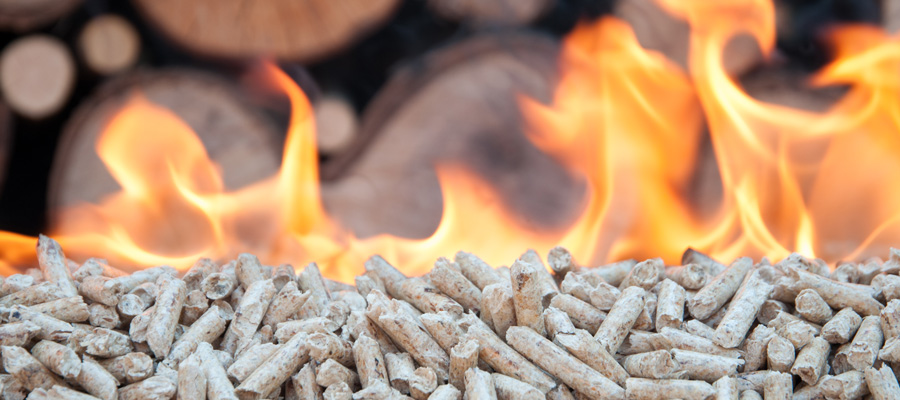Burning our way to a new climate?
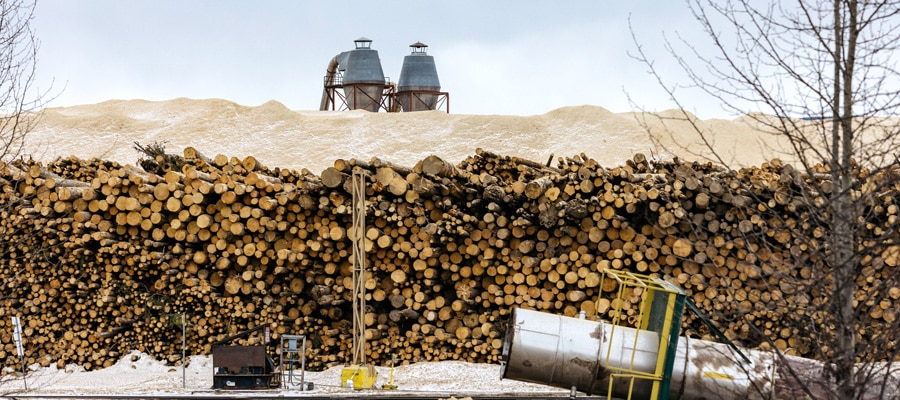
As UK’s Drax makes play for BC’s wood pellet mills, questions grow about wood-fired electricity
With its six massive 660-megawatt power units, the Drax power station in North Yorkshire is the United Kingdom’s largest thermal electricity plant.
When it opened in the mid 1970s, the giant facility burned coal. Today, however, Drax burns something else: wood, a raw material that grew so scarce during the Elizabethan era that it forced the country to convert to coal.
So, when it comes to finding enough wood, Drax has an intractable problem. Only 13 per cent of England, Wales, Scotland and Ireland combined is forested, a number that would be smaller still were it not for major tree-planting efforts over the last century.
Incapable of meeting its raw material needs from within the UK’s borders, Drax relies on imports, which now amount to 10 million tonnes of wood pellets annually. That is effectively double what all of the UK’s forests currently produce in new tree growth each year.
The scale of Drax’s enterprise prompted the company to hire engineers to design new rail cars capable of holding 30 per cent more volume than coal cars. The new cars feature retrievable tops that open for loading and close during transport, thus preventing the wood pellets from getting wet. Meanwhile, the port facilities that those trains travel to can accommodate huge bulk carriers that arrive at dock with as much as 63,907 tonnes of wood pellets. Big as such shipments are, they are not even enough to keep Drax operating for two-and-a-half days.
Only with big “fibre baskets” outside the UK, can Drax meet its needs. In early February it announced that it had reached an agreement with Pinnacle Renewable Energy Inc., British Columbia’s largest wood pellet producer, to purchase the company. Pinnacle is the world’s second biggest pellet producer and owns facilities in Alberta and Alabama as well.
Virtuous energy or a false solution?
Drax says that once its takeover of Pinnacle is complete it will be the world’s largest producer of “sustainable biomass” power. It also says that using wood to create energy is part of a “virtuous cycle” that ultimately benefits “the forestry sector, rural communities and the environment.” All of which allegedly helps the UK and its EU neighbors get off “dirty” coal as part of a broader suite of objectives aimed at lowering greenhouse gas emissions.
Drax’s claims rest on the fact that mountains of wood waste are created all over the world as a result of industrial wood processing. When round logs are turned into rectangular lumber products, only about half of each processed log actually ends up as lumber. What’s left over is sawdust and wood chips, material that is a “perfect” source of fibre for wood pellets, Drax says. Turn such waste into a product that burns efficiently, then plant enough trees to suck up the equivalent of all the carbon that is released during that burning, and, presto—you have a “carbon-neutral” energy source.
New research by the Canadian Centre for Policy Alternatives, however, suggests that Drax’s claims are greenwashing. Whole trees, indeed whole tracts of forest, are being logged with the express purpose of turning trees into a product that is then burned. This results in immediate pulses of greenhouse gasses sent into the world’s overheating atmosphere. Such pulses are as damaging to the earth’s climate as burning coal—and can only be offset over decades—assuming that replanted trees actually live that long. This is a major reason why 500 scientists have warned that wood pellet burning is a “false solution” to climate change.
An ancient relationship
Logging forests to turn them into pellets has many British Columbians worried, including Quesnel mayor Bob Simpson.

Provincial data shows that logging trucks delivered massive numbers of logs to BC wood pellet companies between 2010 and 2020. Photo: © Stand.earth.
“There is no justification with what’s happening with climate change to allow tree harvesting for pellets,” Simpson says, noting that we cannot afford to be “going back to an ancient relationship with the forest [where we] we cut them down to burn them.”
The CCPA’s research shows that from 2010 through 2020, three wood pellet companies in BC— led by Pinnacle—took at least 1.3 million cubic metres of logs out of the province’s forests. At 645,211 cubic metres, Pinnacle alone was responsible for just under half those trees. Prince George-based pellet producer, Pacific Bioenergy, logged slightly less at 611,833 cubic metres while Princeton Standard Pellet was a distant third at a little more than 45,000 cubic metres.
The CCPA crunched the numbers using a searchable database known as the Harvest Billing System, which is maintained by BC’s Ministry of Forests, Lands, Natural Resource Operations and Rural Development. The database provides details on logged trees by or on behalf of companies, where the trees were logged, the quality of the logs and what companies paid in stumpage fees to the Province for each tree they logged.
In Pinnacle’s case, 95 per cent of all the trees ascribed to it in the database were in areas of forest auctioned by BC Timber Sales, an arm of the BC government. The data show that Pinnacle paid an average of $20.57 for each cubic metre of trees it logged during those years and that its total payments to the Province were more than $13.27 million.
Most of its logs came from the Quesnel region, including trees from the extremely rare interior temperate rainforest to the east of Quesnel.
The CCPA asked Josh McQuillan, Pinnacle’s superintendent of biomass, and Mike Thomas, a Pinnacle biomass purchaser, for details on the company’s log supplies. Neither replied. Instead, an email came from Karen Brandt of Pinnacle’s communications department:
“The data you are seeking directly from Pinnacle is competitive in nature and therefore we are unable to disclose. However, I can say that we are 100% committed to ensuring that trees go to their highest and best use. Our pellets are either a direct by-product of the lumber industry, or the purposeful extraction of dead, diseased or damaged or low-quality trees.”
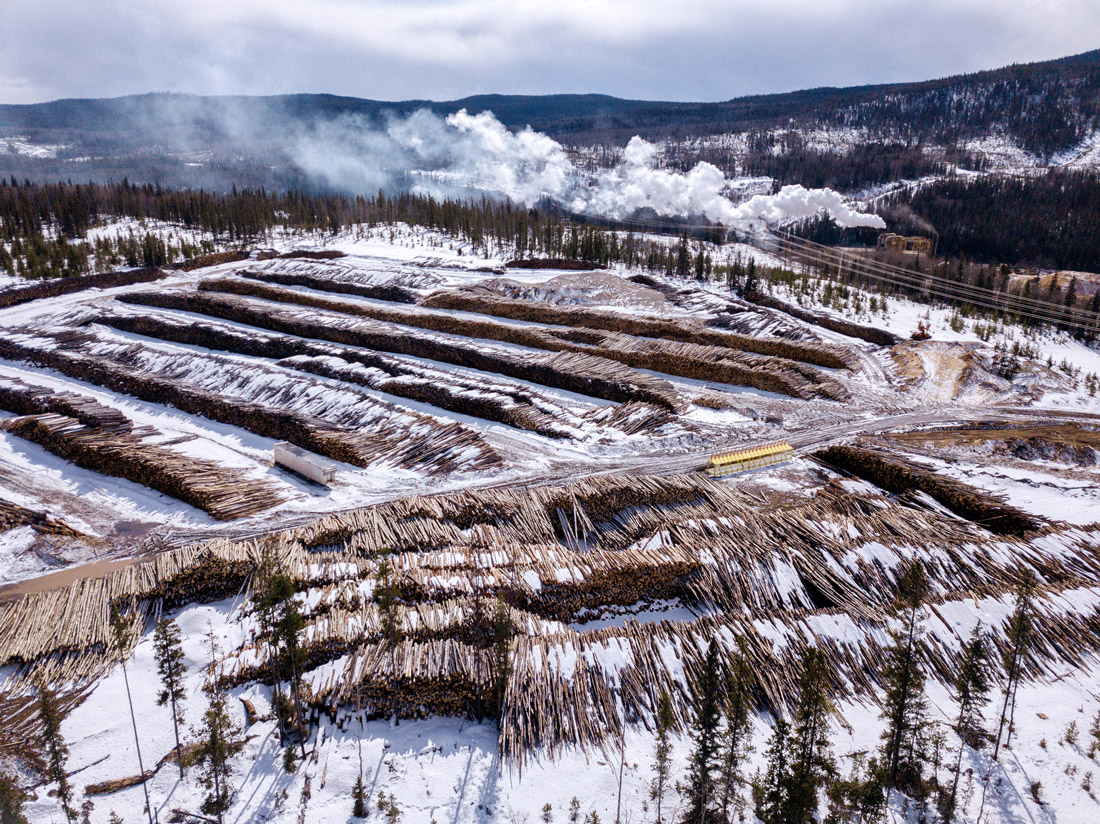
Walls of logs await conversion directly into wood pellets at a Peak Renewable Energy pellet mill in Burns Lake in March, 2021. Photo: © Stand.earth.
In addition to its data analysis, the CCPA has obtained photographs and video showing large numbers of logs amassed at Pinnacle’s pellet mills in Smithers and in Burns Lake. The photographs show pellet mill yards filled with whole logs that are destined to be converted directly into pellets. Simpson says a similar situation exists at a Pinnacle mill to the north of Quesnel. Because of Pinnacle’s decision not to answer any questions about its wood fibre sources, it is unclear whether the photographs represent logs that are in addition to those analyzed by the CCPA.
Logs at Pinnacle’s overflowing pellet mill yards could, for example, be delivered there by major logging companies under a new provincial program known as the “concurrent residual harvest system.” The new system, launched in the spring of 2019, encourages “business agreements” between logging companies and pellet mill operators, and is intended to ensure that “low quality” logs are delivered to pellet mills at deeply discounted stumpage rates. Identifying such logs would require knowing precisely who Pinnacle is doing business with. But that is something the company is apparently unable or unwilling to disclose.
Whatever the ultimate source of Pinnacle’s logs, the data and photographs contradict the pellet industry’s assertions that it uses “residual” (i.e., waste) wood fibre to meet its needs. It also contradicts what BC’s chief forester, Diane Nicholls—one of the most powerful officials in the forests ministry—has said about the province’s pellet mills in a promotional video for the Wood Pellet Association of Canada.
Pellets: the antithesis of value-added
“When you look at pellet production in British Columbia, it’s part of building that circular economy in the forest sector. It uses residuals from sawmill production that may not be used otherwise,” Nicholls says in the video. “And that is a win, because it’s something that is an added value for the benefits of British Columbians. It provides jobs. It fulfills a niche in our sector that we didn’t have before.”
But while making wood pellets adds value of a sort to trees that are logged, Nichols did not address just how few jobs the wood pellet industry actually creates.
Using job figures provided by two unions that represent workers at four of the province’s 14 pellet mills, along with published job figures from industry sources as reported in various media accounts, the CCPA estimates that BC’s 14 pellet mills directly employed just 303 workers in 2020. The United Steelworkers Union and the Public and Private Workers of Canada (PPWC) report that workers in the unionized pellet plants are paid about one third less than their counterparts working in sawmills, and that pay in non-unionized pellet mills may be lower still.
That same year, according to labour force statistics compiled by the provincial government, 45,000 people worked in BC’s forest industry. That figure includes all logging and log hauling jobs, all jobs in wood product mills, and all pulp and paper mill employees. This means that the wood pellet industry last year accounted for just over one half of one per cent of the province’s forest sector jobs.
Drax’s entry also comes at a pivotal moment for the wood pellet industry in BC.
In a move without precedent in the province, another new entrant onto the wood pellet scene—Peak Renewables—is proposing to build the largest wood pellet mill in Canada and by far the largest in BC, in the remote Fort Nelson region.
Because the Fort Nelson region has no active sawmills, the proposed pellet mill would feed on whole trees from the moment it opens. The company says the mill’s biomass would come almost exclusively from logging the region’s aspen trees and that about 1.2 million cubic metres of wood from such trees would be required annually (equivalent to approximately 1.5 million aspen trees).
When the CCPA published details on the proposed pellet mill in February, concerns were voiced immediately from forest industry unions and conservation organizations.
“A truly healthy and stable forest industry is built around the idea of circulating wood between mills, adding value at each step of the way,” Gary Fiege, national president of the PPWC, and Jerry Dias, national president of Unifor, wrote in a letter to Katrine Conroy, BC’s minister of Forests, Lands, Natural Resource Operations and Rural Development.
“The proposed Peak mill is the antithesis of that idea. If built, it will be the first pellet mill in the province that is intentionally designed to churn through whole, living, perfectly healthy trees to make one of the lowest value (from a jobs perspective) forest products on Earth,” they continued.
Conservation North, an organization that is fighting to protect primary, unlogged forests in the interior of the province, where all of BC’s wood pellet mills are located, also wrote to Minister Conroy voicing its opposition to the project. The Fort Nelson region has some of the largest tracts of primary or old-growth forests remaining in the interior.
Protect more forest & add more value
“Wood pellets derived from primary forests are not a renewable source of energy,” Michelle Connolly, Conservation North’s director, wrote. “By definition, primary forests are forests that have never been disturbed by industrial or other human activity, and consequently are irreplaceable. They are ecologically important, they store more carbon and harbor more biodiversity than plantations or second-growth stands of the same forest type, and they mitigate flood risk.”
Numerous letters of opposition to the project were received in the minister’s office. Notably, Minister Conroy was told in her ministerial mandate letter from Premier John Horgan to both conserve more old-growth or primary forests and to ensure that more value is added to the province’s forest products. The ministry must now decide whether or not to allow Canfor Corp., the largest forest company in BC, to transfer logging rights it holds in the Fort Nelson region to Peak, which would mark a critical milestone in Peak’s pellet mill plans.
Opposition to the forest-harvesting project goes well beyond just conservation and union circles. Even the industry association representing Canada’s wood pellet manufacturers has voiced its objections.
Major wood pellet purchasers, such as Drax, do not operate in a vacuum. The European Union has made it abundantly clear that sourcing wood pellets from primary forests, which store huge amounts of carbon in their old trees, is to be avoided because it is neither renewable or carbon neutral.
The wood pellet industry portrays itself as using “residual” wood supplies, largely in the form of waste from sawmills or broken log bits left behind following clear-cuts logging.
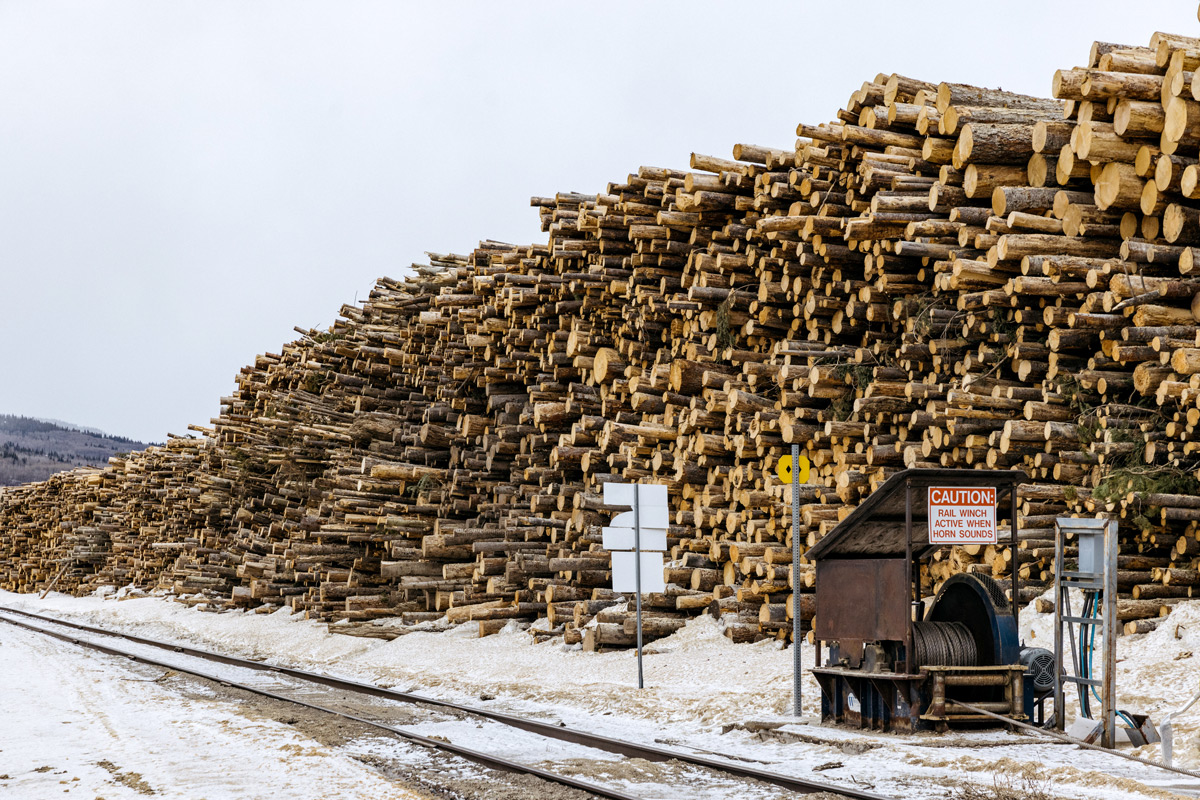
Junk wood? A massive wall of logs about to be turned into wood pellets at a mill in Houston, BC, where Pinnacle Renewable Energy is a partner. Pellet makers say “low-quality” logs have no value and should be turned into pellets and burned. Photo: © Stand.earth.
Shortly after the CCPA released details on the Peak Renewables plan for the forests of Fort Nelson, Gordon Murray, executive director of the Wood Pellet Association of Canada (WPAC), published a commentary criticizing the company’s plan.
“WPAC does not support wood pellet manufacturing proposals that are predicated on the large-scale harvesting of forests for the sole purpose of pellet production,” Murray wrote, adding that his organization was “inundated” with calls after details of Peak Renewable’s plan surfaced.
“WPAC’s history is rooted in a fundamental principle: responsible sourcing,” Murray wrote in Canadian Biomass Magazine.
“That means our pellets are produced entirely from a combination of the waste or residuals left from harvesting and sawmilling activities, the limited quantities of low-quality logs that need to be removed for forest enhancement or salvage projects and material that can’t be used for any other purpose. We are opposed to initiatives that risk the reputation we have built as a leading global supplier in sustainable wood pellet production.”
A last resort
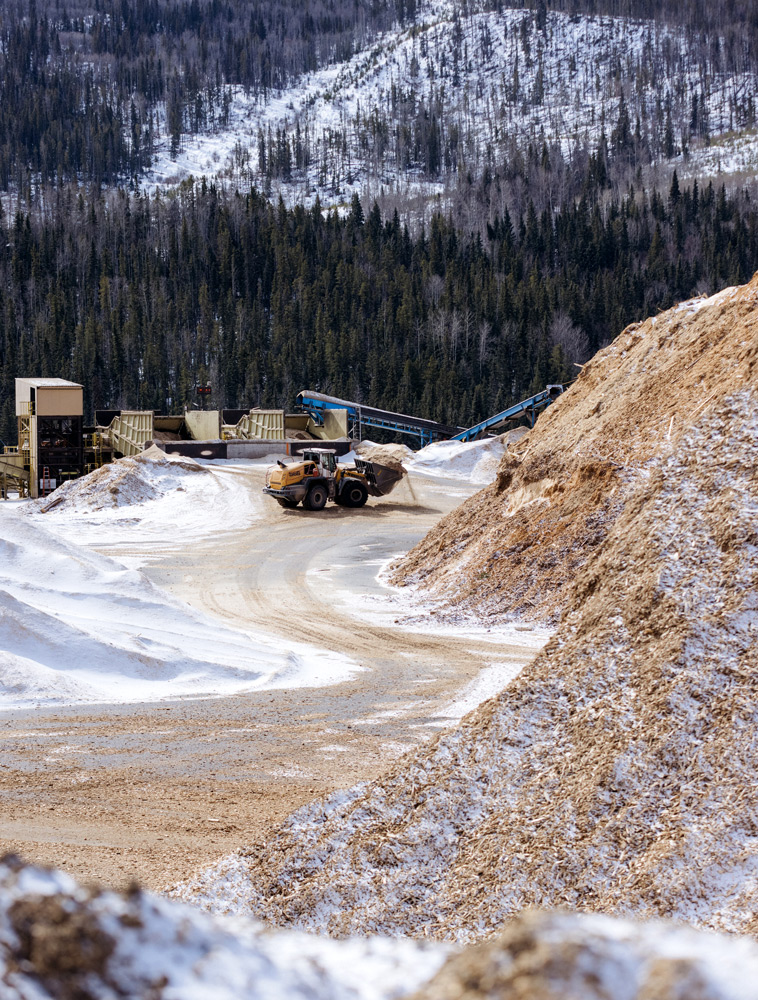
A massive wall of wood chips await conversion to wood pellets at Pinnacle mill in Burns Lake. Critics say far more value and far more jobs are generated when chips go to pulp mills instead. Photo: © Stand.earth.
But what does Murray mean when he says “can’t be used for any other purpose?” In Quesnel, Mayor Simpson says there may be an argument for burning wood at some point. But in his view, it should be at the absolute end of the production train. If a tree is logged, the log should go first to mills where everything from lumber to furniture is made because solid wood products hold onto the carbon in trees and those products may continue to store that carbon for decades and in some cases centuries. After the logs first pass through such mills, Mayor Simpson says, the leftover wood is best sent to a pulp mill (of which there are two in Quesnel).
Traditionally, the mayor notes, pulp mills turned wood chips and sawdust into wood pulp that was then turned into various paper products. But these days, pulp mills can make everything from much-in-demand fibres used in surgical gowns, to bioplastics and biofuels. The pulp industry is only scratching the surface of what can be made from so-called “waste” wood, Mayor Simpson says, whereas the pellet industry is capable of making just one product and a product to immediately be burned at that.
Wood pellets, says the mayor, should be “the last resort,” the caboose at the end of the train.
What have we learned?
In 2018, Pulitzer Prize-winning author, Richard Rhodes, wrote Energy: A Human History, a book that looks at how societies transitioned from one energy source to another. The first chapter, No Wood, No Kingdom, begins in 1598 in London, England, as a group of workers dismantle a theatre building as William Shakespeare looks on. The timbers of the ancient theatre are then carted away and resurrected on the other side of the River Thames to become the Globe Theatre, where some of the playwright’s most famous works were first performed.
Scarcity is what drove the salvage and reassembly operation, as the forests around London—indeed across England—were steadily logged and people had to go farther and farther in search of trees to cut down.
Rhodes’s journey through more than 400 years of history makes two things abundantly clear: energy transitions occur as energy supplies run short, and when the transitions occur, they do not happen overnight because of the immense engineering challenges involved.
Fully transitioning from wood to coal did not happen in the blink of an eye. As coal-mining picked up, mines quickly became flooded with water and people then had to figure out how to dewater the mines, first with the power of horses and later, after horsepower’s limits became better understood, with steam.
Contacted at his home in California, Rhodes said he was mystified that England appears to be reaching far back in time to harness the energy of wood, a raw material in very short supply in the UK today, and one that will ultimately not solve a planetary climate crisis as there is no guarantee that the greenhouse gases emitted when wood is burned today will be made up tomorrow when a tree is planted.
“I really do wonder about this cycling of wood,” Rhodes said. “I really do wonder if there’s a CO2 advantage when they’re shipping these pellets. They’re putting them on diesel-fired freighters, I presume, and shipping them across the Atlantic.”
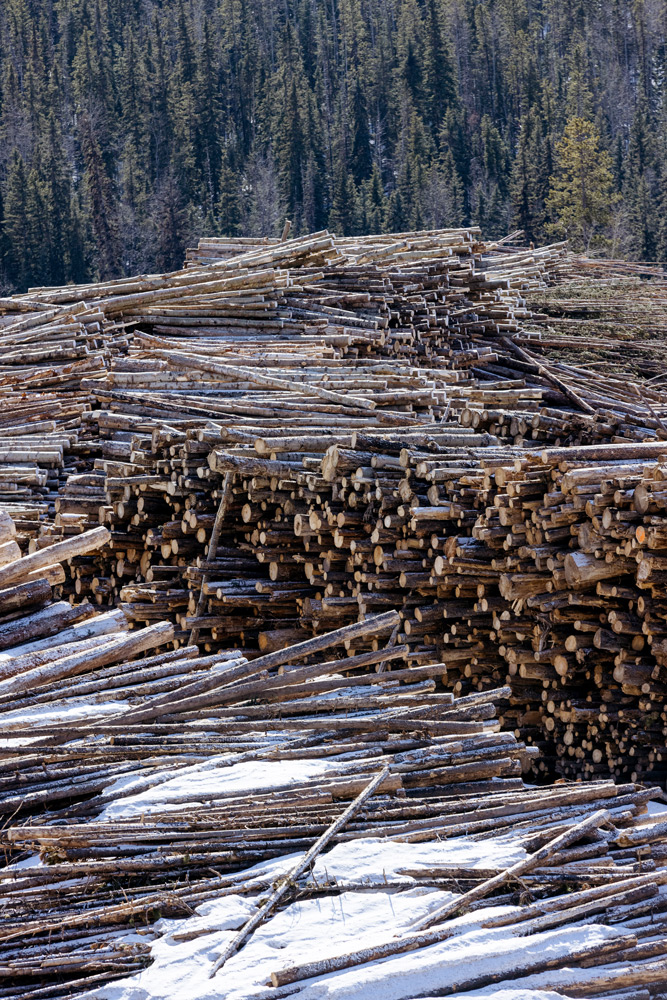
A wall of logs awaits conversion to wood pellets in Burns Lake. Will demand for renewable, “carbon-neutral” wood-fired energy in the UK, European Union and Japan be B.C.’s forests undoing? Photo: © Stand.earth.
Despite this, the Wood Pellet Association of Canada believes that a surge in wood pellet demand lies ahead and that many more wood pellet mills will be built, including in BC.
By 2027, the Association says that installed wood pellet production globally could reach 51 million tonnes annually. That would require a 40-per-cent growth in the industry in just six years.
Where all the wood needed to make those pellets will come from is anyone’s guess.
If the new pellet mill in Fort Nelson materializes and is built to the scale that Peak Renewables envisions, it would bring the number of pellet mills in BC to 15. Based on last year’s logging rate in BC of 52.3 million cubic metres of timber, the province’s pellet mill industry alone would account for the equivalent of just under 15 per cent of the entire provincial log harvest.
The combined annual output of all of those mills would be a little more than 3.1 million tonnes of wood pellets, which is less than one third of what Drax’s power plant in North Yorkshire needs every year.
Can the world’s forests supply enough biomass for another four such power plants while still protecting forest ecosystems and forest industry jobs?
We may soon find out.

